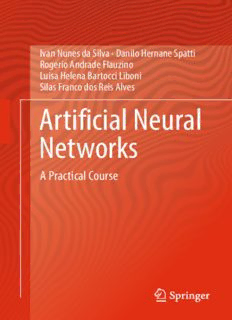
Artificial Neural Networks : A Practical Course PDF
Preview Artificial Neural Networks : A Practical Course
Ivan Nunes da Silva · Danilo Hernane Spatti Rogerio Andrade Flauzino Luisa Helena Bartocci Liboni Silas Franco dos Reis Alves Artificial Neural Networks A Practical Course fi Arti cial Neural Networks Ivan Nunes da Silva Danilo Hernane Spatti (cid:129) Rogerio Andrade Flauzino Luisa Helena Bartocci Liboni Silas Franco dos Reis Alves fi Arti cial Neural Networks A Practical Course 123 IvanNunes daSilva LuisaHelena Bartocci Liboni Department ofElectrical andComputer Department ofElectrical andComputer Engineering, USP/EESC/SEL Engineering, USP/EESC/SEL University of SãoPaulo University of SãoPaulo São Carlos, São Paulo São Carlos, São Paulo Brazil Brazil DaniloHernane Spatti Silas Francodos Reis Alves Department ofElectrical andComputer Department ofElectrical andComputer Engineering, USP/EESC/SEL Engineering, USP/EESC/SEL University of SãoPaulo University of SãoPaulo São Carlos, São Paulo São Carlos, São Paulo Brazil Brazil RogerioAndrade Flauzino Department ofElectrical andComputer Engineering, USP/EESC/SEL University of SãoPaulo São Carlos, São Paulo Brazil ISBN978-3-319-43161-1 ISBN978-3-319-43162-8 (eBook) DOI 10.1007/978-3-319-43162-8 LibraryofCongressControlNumber:2016947754 ©SpringerInternationalPublishingSwitzerland2017 Thisworkissubjecttocopyright.AllrightsarereservedbythePublisher,whetherthewholeorpart of the material is concerned, specifically the rights of translation, reprinting, reuse of illustrations, recitation, broadcasting, reproduction on microfilms or in any other physical way, and transmission orinformationstorageandretrieval,electronicadaptation,computersoftware,orbysimilarordissimilar methodologynowknownorhereafterdeveloped. The use of general descriptive names, registered names, trademarks, service marks, etc. in this publicationdoesnotimply,evenintheabsenceofaspecificstatement,thatsuchnamesareexemptfrom therelevantprotectivelawsandregulationsandthereforefreeforgeneraluse. The publisher, the authors and the editors are safe to assume that the advice and information in this book are believed to be true and accurate at the date of publication. Neither the publisher nor the authorsortheeditorsgiveawarranty,expressorimplied,withrespecttothematerialcontainedhereinor foranyerrorsoromissionsthatmayhavebeenmade. Printedonacid-freepaper ThisSpringerimprintispublishedbySpringerNature TheregisteredcompanyisSpringerInternationalPublishingAGSwitzerland To Sileide, Karla, Solange, Raphael and Elen Preface Whatareartificialneuralnetworks?Whatistheirpurpose?Whataretheirpotential practical applications? What kind of problems can they solve? Withthesequestionsinmind,thisbookwaswrittenwiththeprimaryconcernof answering readers with different profiles, from those interested in acquiring knowledgeaboutarchitecturesofartificialneuralnetworktothosemotivatedbyits multiple applications (of practical aspect) for solving real-world problems. Thisbookaudienceismultidisciplinary,asitwillbeconfirmedbythenumerous exercisesandexamplesaddressedhere.Itexploresdifferentknowledgeareas,such as engineering, computer science, mathematics, physics, economics, finance, statistics, and neurosciences. Additionally, it is expected that this book could be interestingfor those from many other areas that have been inthe focus ofartificial neural networks, such as medicine, psychology, chemistry, pharmaceutical sci- ences, biology, ecology, geology, and so on. Regarding the academic approach of this book and its audience, the chapters were tailored in a fashion that attempts to discuss, step-by-step, the thematic con- cepts, covering a broad range of technical and theoretical information. Therefore, besidesmeetingtheprofessionalaudience’sdesiretobeginordeepentheirstudyon artificial neural networks and its potential applications, this book is intended to be used as a textbook for undergraduate and graduate courses, which address the subject of artificial neural networks in their syllabus. Furthermore,thetextwascomposedusinganaccessiblelanguagesoitcouldbe readbyprofessionals,students,researchers,andautodidactics,asastraightforward andindependentguideforlearningbasicandadvancedsubjectsrelated toartificial neuralnetworks.Tothisend,theprerequisitesforunderstandingthisbook’scontent are basic, requiring only a few elementary knowledge about linear algebra, algo- rithms, and calculus. The first part of this book (Chaps. 1–10), which is intended for those readers who want to begin or improve their theoretical investigation on artificial neural networks, addresses the fundamental architectures that can be implemented in several application scenarios. vii viii Preface Thesecondpartofthisbook(Chaps. 11–20)wasparticularlycreatedtopresent solutions that comprise artificial neural networks for solving practical problems from different knowledge areas. It describes several developing details considered toachievethedescribedresults.Suchaspectcontributestomatureandimprovethe reader’s knowledge about the techniques of specifying the most appropriated artificial neural network architecture for a given application. São Carlos, Brazil Ivan Nunes da Silva Danilo Hernane Spatti Rogerio Andrade Flauzino Luisa Helena Bartocci Liboni Silas Franco dos Reis Alves Organization This book was carefully created with the mission of presenting an objective, friendly, accessible,andillustrative text,whosefundamental concern is, infact, its didactic format. The book organization, made in two parts, along with its com- position filled with more than 200 figures, eases the knowledge building for dif- ferentreaders’profiles.Thebibliography,composedofmorethan170references,is thefoundationforthethemescoveredinthisbook.Thesubjectsarealsoconfronted with up-to-date context. Thefirstpartofthebook(PartI),dividedintotenchapters,coversthetheoretical features related to the main artificial neural architectures, including Perceptron, Adaptive Linear Element (ADALINE), Multilayer Perceptron, Radial Basis Function (RBF), Hopfield, Kohonen, Learning Vector Quantization (LCQ), Counter-Propagation,andAdaptiveResonanceTheory(ART).Ineachoneofthese chapters from Part I, a section with exercises was inserted, so the reader can progressively evaluate the knowledge acquired within the numerous subjects addressed in this book. Furthermore, the chapters that address the different architectures of neural net- worksarealsoprovidedwithsectionsthatdiscusshands-onprojects,whosecontent assiststhereaderonexperimentalaspectsconcerningtheproblemsthatuseartificial neural networks. Such activities also contribute to the development of practical knowledge, which may help on specifying, parameterizing, and tuning neural architectures. The second part (Part II) addresses several applications, covering different knowledge areas, whose solutions and implementations come from the neural networkarchitecturesexploredinPartI.Thedifferentapplicationsaddressedonthis partofthebookreflectthepotentialapplicabilityofneuralnetworkstothesolution of problems from engineering and applied sciences. These applications intend to drive the reader through different modeling and mapping strategies based on arti- ficial neural networks for solving problems of diverse nature. ix x Organization Several didactic materials related to this book, including figures, exercise tips, anddatasets for training neural networks (in tableformat), arealso available atthe following Website: http://laips.sel.eesc.usp.br/ In summary, this book will hopefully create a pleasant and enjoyable reading, thus contributing to the development of a wide range of both theoretical and practical knowledge concerning the area of artificial neural networks. Acknowledgments The authorsare immenselygrateful to themany colleagues who contributed tothe realizationof this compilation,providing precioussuggestions tohelp us promptly on this important and noble work. In particular, we would like to express our thanks to the following colleagues: Alexandre C.N. de Oliveira, Anderson da Silva Soares, André L.V. da Silva, AntonioV.Ortega,DéboraM.B.S.deSouza,EdisonA.Goes,EdnaldoJ.Ferreira, Eduardo A. Speranza, Fabiana C. Bertoni, José Alfredo C. Ulson, Juliano C. Miranda, Lucia Valéria R. de Arruda, Marcelo Suetake, Matheus G. Pires, Michelle M. Mendonça, Ricarco A.L. Rabêlo, Valmir Ziolkowski, Wagner C. Amaral, Washington L.B. Melo and Wesley F. Usida. xi
Description: